The Samsung Galaxy S20+, S20 Ultra Exynos & Snapdragon Review: Megalomania Devices
by Andrei Frumusanu on April 3, 2020 9:30 AM EST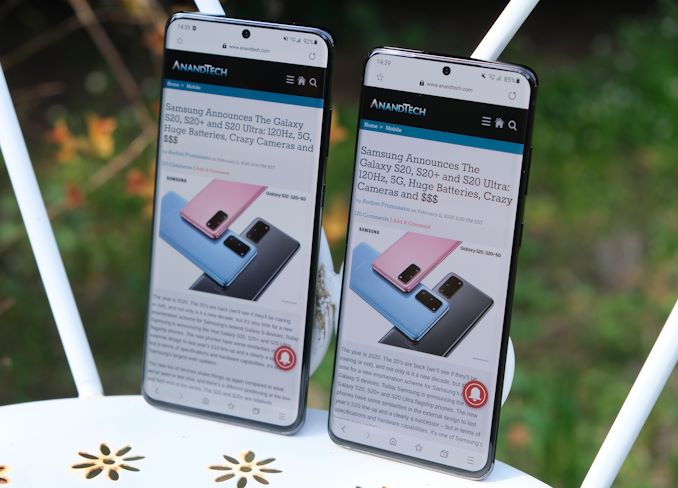
It’s been a long couple of weeks, but the wait is now finally over. Today we’re ready to go on a deep dive into Samsung’s most important phones of 2020; the new Galaxy S20 series represents a huge jump for the Korean company, and also for the wider smartphone industry. The new devices have a lot of brand-new features premiering for the first time in mainstream flagship devices, and some cutting-edge capabilities that are outright new to the industry as a whole.
The S20 series are probably best defined by their picture capturing capabilities, offering a slew of new camera hardware that represents Samsung’s most ambitious smartphone camera update ever. From a “periscope” design telephoto lens with 4x optical magnification and up to a quoted 100x digital magnification, to a new and humongous 108MP main camera sensor with a brand-new pixel array setup, the new Galaxy S20 Ultra is definitely an exotic device when it comes to its photography features. The new Galaxy S20+ also sees some massive new upgrades, ranging from a new, larger main camera sensor, to the innovative use of a 64MP wide-angle module that allows for high magnification hybrid crop-zooming. Overall it too is a big step-up in the camera department and certainly shouldn’t be overshadowed by its Ultra sibling. The phones are not only the first smartphones able to capture 8K video – but they’re also amongst the first consumer grade hardware out on the market with the capability, which is certainly an eye-catching feature.
The new S20 series are also among the first devices to come with the latest generation of processors on the market, pioneering the usage of the new Snapdragon 865 as well as the new Exynos 990 SoCs. In recent years, it’s always been a contentious topic for Samsung’s flagship phones as the company continues to dual-source the SoCs powering its devices – with some years the differences between the two variants being larger than one would hope for. We have both chipset variants of the Galaxy S20 Ultra as well as an Exynos variant of the S20+ for today’s review, and we’ll be uncovering all the differences between the models.
Let’s go over the specifications and the designs in more detail:
| Samsung Galaxy S20 Series | ||||
| Galaxy S20 | Galaxy S20+ | Galaxy S20 Ultra | ||
| SoC | (North America, China, Korea, Japan) Qualcomm Snapdragon 865 1x Cortex-A77 @ 2.84GHz 3x Cortex-A77 @ 2.42GHz 4x Cortex-A55 @ 1.80GHz Adreno 640 @ 587MHz |
|||
| (Europe & Rest of World) Samsung Exynos 990 2x Exynos M5 @ 2.73GHz 2x Cortex-A76 @ 2.50GHz 4x Cortex-A55 @ 2.00GHz Mali G77MP11 @ 800 MHz |
||||
| Display | 6.2-inch 3200 x 1440 (20:9) |
6.7-inch 3200 x 1440 (20:9) |
6.9-inch 3200 x 1440 (20:9) |
|
| SAMOLED HDR10+ 1200nits peak brightness 120Hz Refresh Rate (@FHD+ software rendering) |
||||
| Dimensions | 151.7 x 69.1 x 7.9 mm 163 grams |
161.9 x 73.7 x 7.8 mm 187 grams |
166.9 x 76.0 x 8.8 mm 220 grams |
|
| RAM | 8 GB (LTE) 12 GB (5G) |
8 GB (LTE) 12 GB (5G) |
12 / 16 GB | |
| NAND Storage |
5G = 128 GB LTE = 128 GB + mSD |
5G = 128-512 GB LTE = 128 GB + mSD |
16 GB model = 512 GB 12 GB = 128 or 256 GB + microSD |
|
| Battery | 4000mAh (15.4Wh) typ. 3880mAh (14.93Wh) rated |
4500mAh (17.32Wh) typ. 4370mAh (16.82Wh) rated |
5000mAh (19.25Wh) typ. 4855mAh (18.69Wh) rated |
|
| 15W Wireless Charging | ||||
| 25W Fast Charging |
45W Super Fast Charging |
|||
| Front Camera | 10MP 4K video recording F/2.2, 80-degree |
40MP 4K video recording F/2.2, 80-degree |
||
| Primary Rear Camera | 79° Wide Angle 12MP 1.8µm Dual Pixel PDAF |
79° Wide Angle 108MP 0.8µm DP-PDAF 3x3 Pixel Binning to 12MP 8K24 Video Recording |
||
| fixed f/1.8 optics OIS, auto HDR, LED flash 4K60, 1080p240, 720p960 high-speed recording |
||||
| Secondary Rear Camera |
76° Wide Angle (Cropping / digital zooming telephoto) 64MP 0.8µm F/2.0 optics, OIS 8K24 Video Recording |
24° Telephoto (5x optical magnification) 48MP 0.8µm 2x2 Pixel Binning to 12MP F/3.5 prism optics, OIS |
||
| Tertiary Rear Camera |
120° Ultra-Wide Angle 12MP 1.4µm f/2.2 |
|||
| Extra Camera |
- | Time of Flight (ToF) 3D Sensor | ||
| 4G / 5G Modem |
||||
| Snapdragon 5G - Snapdragon Modem X55 (Discrete) (LTE Category 24/22) DL = 2500 Mbps - 7x20MHz CA, 1024-QAM UL = 316 Mbps 3x20MHz CA, 256-QAM (5G NR Sub-6 + mmWave*) DL = 7000 Mbps UL = 3000 Mbps *Depending on region and model |
||||
| Exynos 5G - Exynos Modem 5123 (Discrete) (LTE Category 24/22) DL = 3000 Mbps 8x20MHz CA 1024-QAM UL = 422 Mbps ?x20MHz CA, 256-QAM (5G NR Sub-6) DL = 5100 Mbps |
||||
| Exynos 4G - Exynos Modem 5213 (Discrete) (LTE Category 24/22) DL = 3000 Mbps 8x20MHz CA 1024-QAM UL = 422 Mbps ?x20MHz CA, 256-QAM |
||||
| SIM Size | NanoSIM + eSIM | |||
| Wireless | 802.11a/b/g/n/ac/ax 2x2 MU-MIMO, BT 5.0 LE, NFC, GPS/Glonass/Galileo/BDS |
|||
| Connectivity | USB Type-C no 3.5mm headset |
|||
| Special Features | Under-screen ultrasonic fingerprint sensor | |||
| (Qualcomm QC 2.0, Adaptive Fast Charging, USB-PD), reverse wireless charging (WPC & PMA), IP68 water resistance |
||||
| Launch OS | Android 10 with Samsung OneUI 2.0 | |||
| Launch Prices | 128GB 5G: $999 / 999€ / £899 |
128GB 5G: $1199 / 1099€ / £999 512GB 5G: $1299 / 1249€ / n/a £ |
128GB 5G: $1399 / 1349€ / £1199 512GB 5G: $1499 / 1549€ / £1399 |
|
| 4G variants for 100€ / 100£ cheaper available only in certain markets |
5G only | |||
Hardware-wise, the new S20 series essentially checks all the boxes that you’d expect (or could ask for) in a 2020 phone. The new Snapdragon 865 and Exynos 990 both bring lots of performance to the table, and probably the most talked about aspect of the new generation is their ability to support new 5G networks. In most developed countries with early 5G deployments, the S20 series are indeed positioned as 5G devices – and technically their naming scheme contains the 5G moniker, such as the “Galaxy S20+ 5G” or the “Galaxy S20 Ultra 5G”, including our review devices today.
Samsung however still offers 4G variants of the phones in some countries where 5G rollout is slow – these still feature the newest SoCs and their 5G capable modems, however they lack the corresponding 5G RF hardware needed to enable that radio connectivity. The silver lining here is that these 4G models do come at a cheaper price than the 5G variants – essentially matching the pricing of the S10 series in their respective configurations.
The US in particular gets the most capable and connectivity-rich models of the S20 series; it’s currently the only market where the new phones will be launching with mmWave capabilities – at least at this point in time. It’s to be noted, however, that mmWave connectivity is currently only available on the S20+ and S20 Ultra, as Samsung’s been quoted to say that the smaller S20 didn’t have sufficient internal space to house the new mmWave modules from Qualcomm. A special variant of the S20 with mmWave is said to follow up on Verizon in a few months.
The spec list is long and complex, but a few highlights are that the new phones now come with 12GB of RAM for the 5G models, with that going up to a massive 16GB for the 512GB Galaxy S20 Ultra. 128GB remains the minimum storage configuration, and the phones come with UFS 3.0-type storage chips, promising top of the line performance. The microSD slot also survives – which might be a boon for those wanting to record 8K video, because at 1GB/minute, it’s a storage killer.
At the front of the new devices, we see a new design language dictating the new form-factor and aesthetics of the series. Centre-stage we find Samsung’s newest generation AMOLED screens. Compared to the S10 series, things have been elongated to a new, taller 20:9 aspect ratio, with the phones now all seeing a notable lengthening of their dimensions by a couple of millimeters.
The display resolution is still 1440p – 3040x1440 to be exact – and unlike the Note10 series, the smaller S20 doesn’t see a downgrade to a 1080p panel, to which I've breathed a sigh of relief. What does make the S20 series' screen super special though is their support of a high 120Hz refresh rate. Samsung didn’t just aim to match the 90Hz capabilities of the 2019 competitors, but to one-up them. It’s an amazing feature that really stands out for the S20s, giving one a sense of fluidity and smoothness that usually reserved just for special gaming devices.
Samsung has also redesigned their hole-punch camera. The new design language had already been introduced in the Note10 series, but the S20 phones further reduce the size of the camera cut-out. Comparing the S20+ to last year’s S10+, the difference is quite striking. The reduced footprint also reduces the thickness of the notification bar, which had been quite thick on the S10 series, further expanding the usable screen estate of the phones. I think, barring an actual see-through-screen front camera design, it’s as sleek a design as we’re going to get until that technology is ready for prime-time.
Part of the screen’s design, but also of the wider language of the phone, is the reduced curvature of the display. Curved screens have been a main-stay for Samsung flagship phones since the Galaxy S8, but over the years the company has refined the designs for better usability. This year, the S20 series sees the largest regression of the display curvature to date, with a much-reduced radius that doesn’t go nearly as far to the sides of the phones as its predecessors. What you end up with is the flattest screen from a Galaxy S phone in recent years, without actually going fully flat.
While the front curvature has been reduced, the back curvature has been expanded. In this respect the phone has more in common with the Galaxy S10 5G than the regular S10 series, as it adopts the same, much narrower side-frame aesthetic. The rest of the side of the phone is covered by the curved back glass panel – and I have to say that this is probably one of my favorite design features of the S20+, as it lends it some incredible ergonomics that allow it an in-hand feel that’s much narrower than what you’d expect from the phone. It’s only 0.4mm narrower than the S10+, but it just feels that much better in hand thanks to the new curves.
It’s to be noted that the curved back glass sides aren’t just done for aesthetics, but also serve as a technical enabler for the mmWave modules which sit on the inside of the phone (two modules facing the lateral sides, one facing the back). Had the metal frame been wider, as in classical phone designs, these would have a harder time transmitting and receiving such high-frequency signals in an optimal manner.
On the back of the phone there’s obviously the new camera designs – we’ll go into the technical details of the new cameras in a dedicated page later in the article. I’ll also talk about the S20 Ultra more extensively in just a bit, but first I wanted to give my opinion on the S20+.
Having used the phone for a couple of weeks now, I’ve gotten used to the new camera position. It’s a departure from the classical center-camera positioning we’ve been used to in Galaxy S phones ever since the first model 10 years ago, but it’s become a technical necessity given the more complex camera systems out there and the better internal component space management it allows. It’s a bigger camera bump as that of the S10 series – and yes, it now causes the phone to no longer be stable on a flat surface, with it now wobbling when pressing the left side of the screen. Other phones out there have had this characteristic for years (Looking at you, iPhones), so it’s just something that one has to accept and live with.
A few other details of the S20 series' design include changes in their finish. I do like that we once again have a black variant that’s actually fully black, including the metal frame. One aspect that I think Samsung missed the mark on was that they did not adopt a matte / frosted back glass option. Such designs have been slowly introduced by vendors since 2018, and last year was most notably made mainstream by Apple’s iPhone 11 Pro series. The Galaxy S20s still being the same glossy finger-print magnets in contrast feels a bit dated.
Another change is in the audio department. The new center front-facing camera design means that the earpiece speaker has to undergo a bit of an internal redesign. The S20 here is a ton louder than its predecessor, to the point that I find that the earpiece speaker is now louder than the main speaker. We’ll be going over the audio quality changes later on in the article, but it’s probably one of the more striking differences you’ll notice compared to the S10 series. The main bottom speaker remains similar to the S10.
And course, the S20 series no longer come with 3.5mm headphone jacks. I think I’ve riled on the topic enough over the years, but least to say I’m very disappointed by Samsung for this anti-consumer choice. Sony notably tracked back on their decision to deprecate the headphone jack, bringing it back on the new Xperia 1 II – so maybe there’s some hope Samsung might do the same, as long as there’s sufficient negative feedback from users.


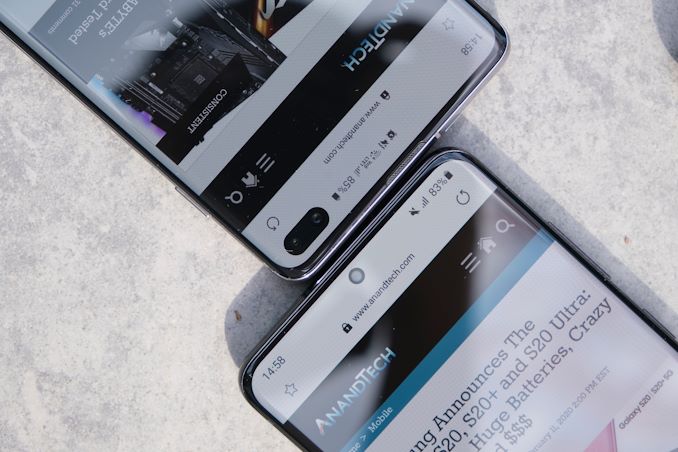
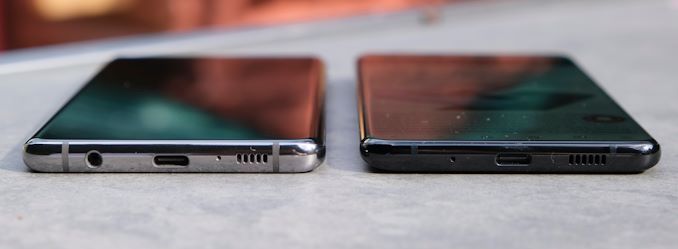
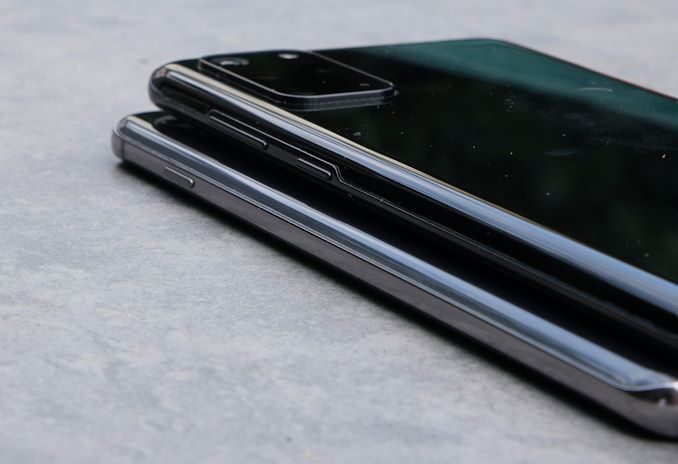

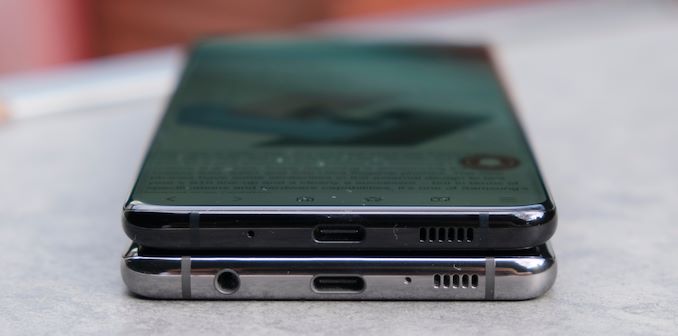








137 Comments
View All Comments
Shadowfax_25 - Friday, April 3, 2020 - link
Excellent article, Andrei. The team over at XDA Developers managed to identify the adb commands which would allow you to set the display to either of the other refresh rates, so I'm sure Samsung could in some way introduce variable refresh rate switching.Here's the article for your perusal: https://www.xda-developers.com/samsung-galaxy-s20-...
Andrei Frumusanu - Friday, April 3, 2020 - link
Yea I saw that. In an ideal case Samsung would actually implement their own pseudo-VRR mode that switches between the display refresh rates based on content.Shadowfax_25 - Friday, April 3, 2020 - link
One more thing: it appears as if the commentary around the speaker evaluation is missing.Shadowfax_25 - Friday, April 3, 2020 - link
Ignore, looks like it was a caching issue on my side.eastcoast_pete - Friday, April 3, 2020 - link
Yes, but that would make sense, and this is Samsung we're talking about here. Still, there's hope, I guess.CecilFitzgerald - Monday, October 12, 2020 - link
Machine learning is in great need now. During the coronavirus period, it would be nice to identify some dependencies and foresee what will happen next in the world. By the way, if you also need to write an essay on machine learning, then i advise you to turn to https://buypapercheap.net/affordable-term-papers-f... which offers writing term papers at affordable prices.yeeeeman - Friday, April 3, 2020 - link
Andrei, amazing review TBH. You have outdone yourself once again and, fie vorba intre noi, cred ca esti succesorul cel mai potrivit pentru Anand. Esti cel mai profi si cand vine vorba de detalii tehnice, dar si de idei interesante de comparatie intre diferite device-uri. Am scris in romana sa nu se supere colegii tai.Please try to add to the energy efficiency table, Ice Lake scores and maybe some energy usages like you have for mobile devices? That would be amazing!
Unashamed_unoriginal_username_x86 - Friday, April 3, 2020 - link
avem traducere Google, tipuleyeeeeman - Friday, April 3, 2020 - link
Tipule, era o glumita. Logic ca poti folosi traducerea.abufrejoval - Saturday, April 4, 2020 - link
Born German with Latin as my first foreign language, and with fluent Spanish and French picked up later, written down Romanian isn't nearly as hard to understand as the spoken language... bine, bine!